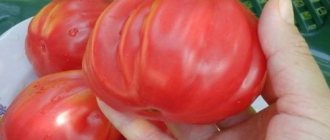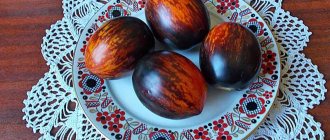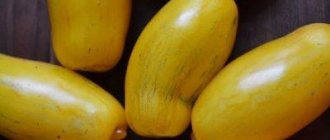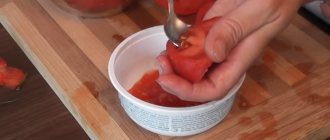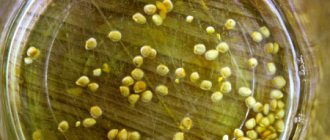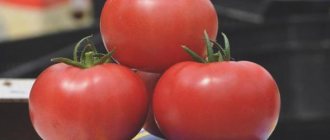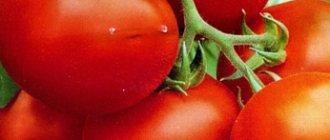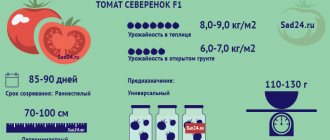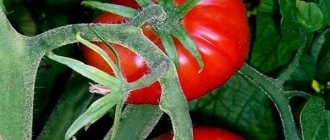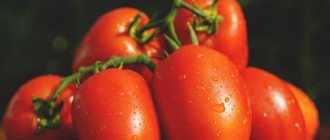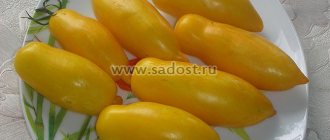Basic ideas about the variety
Thanks to its characteristics, the tomato deserves respect among vegetable growers. Detailed information helps to properly grow the crop on the site. The variety has several names:
- Cassidy's Madness.
- Kasadi's recklessness.
- Cassidy's quirk.
Bush:
- Semi-determinant.
- Height 1.2–1.4 m.
- Ripens within 105–115 days.
- Tomatoes in a brush 4–6 pcs.
Tomato:
- Red in color, but with golden veins.
- The shape is elongated, “icicle” as summer residents call it.
- Length 10 cm.
- Weight 60–150 g.
- The density is high.
- The skin is thick and dense; it does not crack on bushes or during canning.
- It can be stored for a long time and can easily be transported over various distances.
These properties help the tomato become a favorite in many areas.
Growing tomatoes
The main feature of the hybrid is planting using both seedlings and non-seedlings.
How to prepare seeds?
Preparing seed material is quite simple. Seeds do not need disinfection or any other treatment before planting. Before sale, tomato seeds undergo all disinfecting and stimulating procedures.
Sowing seed material
There are two types of sowing seeds - planting in a container for seedlings or directly on the beds.
Containers and soil are prepared for growing seedlings. The soil consists of a mixture of ordinary soil with peat or humus.
Seeds are planted in containers to a depth of about 1.5-2 cm.
Containers with future seedlings are placed in a warm room. To improve germination, it is recommended to cover them with film.
After the first shoots appear, the film must be removed. The seedlings should be placed in a well-lit place and watered with warm, settled water.
IMPORTANT: The sown seeds should be sprinkled with peat.
When the first true leaves grow on the seedlings, they need picking. Seedlings also need to be fed using special complex mineral fertilizers.
With the seedless growing method, the seeds are sown directly on the beds, which are pre-fertilized with humus. The planted seeds are sprayed with warm water and covered with film.
After the sprouts appear, the plantings are thinned to increase the yield of tomatoes.
IMPORTANT: Plants grown in this way have very high immunity.
Rules for planting seedlings
Young bushes are planted in open ground or a film greenhouse in the second half of May. The distance between seedlings is maintained at about 40-50 cm. The distance between the beds should be at least 60 cm.
How to grow crops on the plot?
They use the seedling growing method. Seeds are sown in prepared soil 2 months before transferring to a permanent place. The period is calculated individually, depending on weather conditions.
The more attention the seedlings receive, the more solid the foundation for the future harvest. Temperature conditions are required, the optimum is +20–22 ⁰С. The light mode is 14 hours a day; if there is a lack of sunlight, it is recommended to install additional lighting.
Features of agricultural technology
The hybrid easily tolerates low temperatures and heat, short droughts and prolonged rains. Despite these characteristics, the tomato needs proper care.
- Plants are grown in beds in the garden, but in cool areas, at least for the first time, it is better to set up a greenhouse.
- The stem is tall and needs staking, so simultaneously with planting, supports are installed in a permanent place. No more than 4 plants are planted per 1 m².
- During the growing season, the tomato is planted and shaped. Failure to comply with these procedures leads to an increase in green mass and a decrease in yield. In addition, additional stems and leaves thicken the bush. As a result, the plant is attacked by a fungus.
Attention! If a tomato is grown in an open bed in a cool area, the main shoot is pinched at the end of July, otherwise the set fruits will not have time to ripen.
Watering and fertilizing
Overmoistening and drying out of the soil is not allowed. Complex fertilizers help seedlings grow faster.
Diving is carried out in phase 2 of the true leaf. Planting in separate containers will help form a powerful root system.
4 plants per 1 m2 are planted in open ground. Form into 3-4 stems, tying them to supports.
See also
Description of the tomato variety Earthly Love and its characteristicsRead
Further care consists of fertilizing, watering, loosening and hilling the planting beds.
Features of cultivation
Many summer residents think that they need to plant seedlings early. However, the opinion is erroneous. Plants require optimal conditions for normal development. It is best to start planting in April. Such seedlings will be able to bloom in 40 days.
Before sowing seeds, they need to be prepared. To do this, the seed must be soaked in a solution with potassium permanganate for half an hour. In order for the seeds to germinate, it is necessary to treat them with a growth stimulator. After this, the seeds must be washed with water and dried.
Tomatoes prefer to grow on leveled soil. Therefore, the soil in the greenhouse should be prepared in advance. In addition, you need to make small grooves and place the seeds in them.
Important. The top of the crops should be sprinkled with soil sifted through a sieve. This will allow the seeds to be evenly buried and improve their germination.
Application and yield volume
Tomatoes can be used for any purpose. Housewives especially praise the unusual appearance of the Kasadi Madness tomato. Whole canning, processing, preparation of all types of preparations, fillings for canning and much more. Fresh salads will also not suffer from the presence of this tomato variety in them.
The yield is high, especially if you fulfill the necessary agrotechnical requirements, tie up and plant the bushes.
Description
The original cherry tomato variety “Kiss” was bred by agro specialists and is intended for greenhouse and open ground. The variety is early ripening, stress-resistant, and has the following characteristics:
- strong, erect shoots that require garter during fruit ripening;
- medium-leafy, powerful, tall bushes;
- foliage is oval-elongated, medium in size, slightly wrinkled,
- foliage color - rich, emerald green;
- flowers are small, yellow, collected in large, racemose, complex inflorescences (up to 150 flowers in each)
- clusters with large fruits (the number of fruits reaches 140-150 pieces), in some cases require the installation of supports;
- ripe fruits are obovoid in shape with a thin spout, weighing up to 25 g;
- the color of ripe fruits is bright red;
- the taste of ripe tomatoes is typically tomato-like, with sourness;
- plant height - 1.5-1.9 m;
- ripening period - about 3 months;
- the yield of one bush is 8-11 kg;
- resistance to diseases and environmental influences;
- good seed germination;
- versatility of use (fresh, as individual dishes, as a gastronomic decoration, for preservation, freezing).
Plant immunity
Preventive treatment against diseases is required, since there is no immunity. Timely assistance to the bushes will help save the harvest.
It is advisable to use chemicals before flowering, after which you need to use folk remedies.
Loosening and mulching, removing weeds and using green manure for the soil helps.
The opinion of summer residents regarding Kasadi Madness tomatoes
Summer residents provide a lot of useful information; just look for reviews about the variety. You can also find recommendations on the care and cultivation of crops online.
- Vladimir: “Only positive emotions are associated with Kasadi’s Madness. Very productive tomatoes, pleased with all the characteristics. I was attracted by the description and will now remain in the collection for future years.”
- Natalya: “The fruit has a very unusual appearance. The jars look original and even exotic.”
Many varieties win the respect of summer residents; Madness Kasadi is famous among them for its productivity, excellent taste and other characteristics.
Charming tomatoes with good taste - Marfa F1 tomato: variety description and care tips
The tomato kingdom is a huge variety of varieties, among which the Marfa F1 tomato stands out in a special way. The hybrid comes from Holland, was bred for planting in temperate latitudes, but can be grown throughout the country - both in the north and in the south. It is interesting for its important properties - productivity, marketability, endurance of weather fluctuations.
| Height | Landing location | Ripening time | Fruit color | Fruit size | Origin | Fruit shape |
| Tall | Greenhouse, Open ground | Mid-season | Reds | Average | Hybrid | Flat-round |
Description and characteristics of the variety
Tomato Marfa F1 is successfully grown in Siberia and the Urals, in the Crimea and Krasnodar Territory, in the central regions.
- bushes are indeterminate, tall, reach 2 m, require pinching;
- shoots are compact and sparsely leafy;
- There are 8-9 fruiting clusters, the number of tomatoes on each is from 6 to 8.
What are the characteristics of tomatoes:
- average weight 130-140 g;
- ribbing is weakly expressed;
- the skin is glossy, durable, not cracking;
- the pulp is fleshy, moderately juicy and dense, oily when cut;
- seed chambers up to 4;
- dry matter 5-6%.
Advantages and disadvantages
- prolonged fruiting;
- transportability;
- long shelf life;
- the ability to grow in all regions;
- tolerance to temperature fluctuations, recurrent frosts;
- good immunity to multiple pathogens;
- excellent product and taste qualities.
Minuses:
the need for tying and feeding.
Features of cultivation and storage
Green manure crops - lupine, phacelia, oats - are planted in the beds where tomatoes will be planted in the fall. This will significantly increase fertility. In the spring, the soil is disinfected by treating:
- 1% Bordeaux mixture;
- 1% "Fitosporin";
- lime solution;
- potassium permanganate.
Fertilizers include compost, saltpeter, ash and a phosphorus-potassium mixture.
There are no more than 3 bushes per 1 m2. Standard care basics:
- shaping, guiding in 2-3 trunks;
- stepsoning 1 time in 10 days;
- watering 2 times a week, water rate 8 liters per plant;
- root and foliar feeding; fertilizers include solutions of mullein, superphosphate, and bioinfusions;
- mulching with a layer of 8 cm.
Planting and care
The soil mixture is prepared from fertile turf, sand and peat are added for lightness and looseness, and rotted compost is added from fertilizers.
How to grow strong seedlings:
- feeding 2-3 times with “Krepysh” or “Kemira-universal”;
- irrigation with settled water;
- diving at the stage of 3 true leaves.
